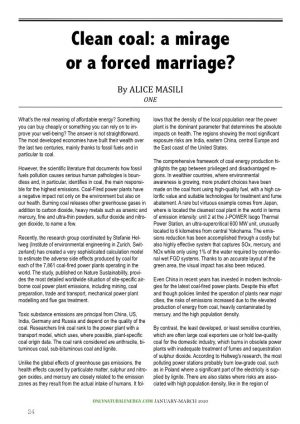 What’s the real meaning of affordable energy? Something you can buy cheaply or something you can rely on to improve your well-being? The answer is not straightforward.
What’s the real meaning of affordable energy? Something you can buy cheaply or something you can rely on to improve your well-being? The answer is not straightforward.
The most developed economies have built their wealth over the last two centuries, mainly thanks to fossil fuels and in particular to coal.
However, the scientific literature that documents how fossil fuels pollution causes serious human pathologies is boundless and, in particular, identifies in coal, the main responsible for the highest emissions. Coal-Fired power plants have a negative impact not only on the environment but also on our health. Burning coal releases other greenhouse gases in addition to carbon dioxide, heavy metals such as arsenic and mercury, fine and ultra-thin powders, sulfur dioxide and nitrogen dioxide, to name a few.
Recently, the research group coordinated by Stefanie Hellweg (Institute of environmental engineering in Zurich, Switzerland) has created a very sophisticated calculation model to estimate the adverse side effects produced by coal for each of the 7,861 coal-fired power plants operating in the world. The study, published on Nature Sustainability, provides the most detailed worldwide situation of site-specific airborne coal power plant emissions, including mining, coal preparation, trade and transport, mechanical power plant modelling and flue gas treatment.
Toxic substance emissions are principal from China, US, India, Germany and Russia and depend on the quality of the coal. Researchers link coal rank to the power plant with a transport model, which uses, where possible, plant-specific coal origin data. The coal rank considered are anthracite, bituminous coal, sub-bituminous coal and lignite.
Unlike the global effects of greenhouse gas emissions, the health effects caused by particulate matter, sulphur and nitrogen oxides, and mercury are closely related to the emission zones as they result from the actual intake of humans. It follows that the density of the local population near the power plant is the dominant parameter that determines the absolute impacts on health. The regions showing the most significant exposure risks are India, eastern China, central Europe and the East coast of the United States.
The comprehensive framework of coal energy production highlights the gap between privileged and disadvantaged regions. In wealthier countries, where environmental awareness is growing, more prudent choices have been made on the coal front using high-quality fuel, with a high calorific value and suitable technologies for treatment and fume abatement. A rare but virtuous example comes from Japan, where is located the cleanest coal plant in the world in terms of emission intensity: unit 2 at the J-POWER Isogo Thermal Power Station, an ultra-supercritical 600 MW unit, unusually located to 6 kilometres from central Yokohama. The emissions reduction has been accomplished through a costly but also highly effective system that captures SOx, mercury, and NOx while only using 1% of the water required by conventional wet FGD systems. Thanks to an accurate layout of the green area, the visual impact has also been reduced.
Even China in recent years has invested in modern technologies for the latest coal-fired power plants. Despite this effort and though policies limited the operation of plants near major cities, the risks of emissions increased due to the elevated production of energy from coal, heavily contaminated by mercury, and the high population density.
By contrast, the least developed, or least sensitive countries, which are often large coal exporters use or hold low-quality coal for the domestic industry, which burns in obsolete power plants with inadequate treatment of fumes and sequestration of sulphur dioxide. According to Hellweg’s research, the most polluting power stations probably burn low-grade coal, such as in Poland where a significant part of the electricity is supplied by lignite. There are also states where risks are associated with high population density, like in the region of Pretoria in South Africa, or with inadequate fumes treatment, as in Moscow, Russia, or near Jakarta in Indonesia.
According to the study since 2000, there has been a decrease in greenhouse gas emissions, mainly due to the introduction of highly efficient technology, such as super-critical and ultra super-critical coal power plants in China and India. Unfortunately, they have not replaced the whole fleet yet. When emissions drop, there will be significant health improvements in those places.
A confirmation of the Swiss research main findings comes from the study “Mortality and hospitalisation associated with emissions of a coal power plant”, published in Science of the Total Environment. «The health risk is so high that, the sooner we get out of coal, the better. Decarbonisation is necessary, not only to save the climate, but also human lives “. The appeal of Fabrizio Bianchi, head of the IFC-CNR research unit of Pisa and co-author of the epidemiological survey, is unconditional.
The research was performed on 144.019 people residing in 12 municipalities around the coal power plant of Vado Ligure (Italy) from 2001 to 2013 or in sub-periods. The results showed an excess of mortality in the areas with the highest exposure of polluting sources equal to 49 per cent. In particular for disease to the circulatory system (men + 41%, women + 59%), the respiratory system (men + 90%, women + 62%), the nervous system and sense organs (men + 34%, women + 38%) and to lung cancer among men (+ 59%). Even the analysis of hospital admissions has provided results consistent with those of mortality. These findings, therefore, indicate that it is necessary to reduce the exposure to pollutants, keeping concentrations emitted well below legal limits. These legal limits are often considerably higher than those suggested by the most recent scientific evidence.
The Italian owner company Tirreno Power, now on trial for environmental and health disaster, immediately branded the IFC-CNR study as “based on old data”. Epidemiologists countered that those adverse events are not guessed or potential, as Tirreno Power stated, but deaths and illnesses that really happened”.
Nowadays, when we talk about coal, the attention is generally focused on the climate and on the environmental pollution associated with its combustion, overlooking the positive economic impacts that activities related to its use may have. According to the IEA Clean Coal centre report “The economic and strategic value of coal”, the use of coal has positive effects not only on related activities, such as mining and production of electricity and heat but also on entire communities and the supply chain closely linked to the industrial system.
The ripple effect on the rest of the economy generates benefits in terms of direct, indirect and induced wealth. Among the main positive impacts: employment, support for communities with tax revenues, affordable electricity supply, resilience in the electricity grid and reliability of primary energy supplies. In Asia, the coal sector still provides a driving force for economic growth and employment. China covers half of the production and consumption of coal in the world, and the coal sector alone employs about three million people.
When it comes to coal exploitation China and the rest of the world are not on the same wavelength. In the period between January 2018 and June 2019, countries outside China have decreased their total coal capacity by 8.1 gigawatts (GW) – shutting down old plants turned out to be faster than building new ones. But over the same period, China increased its coal fleet by 42.9 GW (NGO Global Energy Monitor).
In emerging economies and developing countries, as India and Pakistan, the internal resources of coal and lignite play an essential role in the security of supply, helping to guarantee energy security and reduce high dependence on imports. In Africa, too, the aim is to increase the role of coal in the energy sector to promote fuel diversity and lower oil and gas dependence.
In 2023, Africa will be the most populous continent in the world and providing energy at a low cost is the next challenge on the global energy market.
On the contrary, the European economy of coal-fired power plants is not at all prosperous. According to the latest Carbon Tracker report, “Apocoalypse Now“, four out of five plants, in the EU borders, do not guarantee profits but losses which have been estimated by the think-thank financial analysts, at about 6.6 billion euros for the only 2019.
The continuous fall in the cost of renewable energy, the regulations on air pollution and the recent collapse of gas prices in the EU have made coal less and less competitive (even though coal price itself has fallen).
A severe blow came from the soaring rights for CO2 emissions, whose value has tripled in the last year, stabilising between 25 and 30 euros per ton: levels that, for the first time in the history, make little even lignite convenient, says Carbon Tracker.
Unless a reversal of the market situation occurs, coal could theoretically become extinct for economic reasons in Europe before 2030, the desired date for the phase-out of the Paris climate agreements. But it is a matter of theory. The phase-out has already begun. Compared to 2018, the generation of hard coal decreased by 39%, whereas lignite by 20. Carbon Tracker estimated that 76% of EU hard coal and 84% of lignite generators are currently at a loser. The Germany, which however set the final closure of all its plants back in 2038, could lose € 1.97 billion in 2019 and, according to the IEA scenario over 2°C, the EU should be coal-free by 2030.
Losses do not affect everyone in the same way. In some countries, thanks to government aid and high prices in the electricity market, burning coal can still be convenient at least from a financial point of view. An excellent example of large profits comes from Poland, where the government heavily subsidises the coal sector, from which about 80 per cent of the national energy mix derives, and the prospect is to continue to depend on coal at least until 2050.
The growing tendency among western European countries to formally announce policies for the gradual abandonment of coal, Eastern Europe still depend heavily on hard coal and lignite. Coal accounted for 80% of total production in Poland, 43% in the Czech Republic and 39% in Bulgaria. It is also a truth that the growth of renewable energies in those countries struggles due to the lack of political subsidies.
Although a gradual elimination of the use of coal from the energy mix is in progress, and there is no way back, there are still large communities that depend heavily on local mining. The gradual elimination or complete elimination of the carbon assets will hit hard in those communities.
The decarbonisation process will undoubtedly bring benefits to the environment and health. Still, the complex transition phase of the industrial economy will have to be tackled comprehensively, providing full support to the entire supply chain closely linked to the coal industry system. It is a necessary action to avoid choosing between starving or getting sick.
Alice Masili


